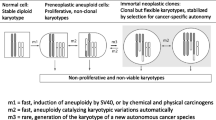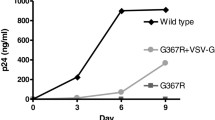Summary
CV-1 cells which survived SV 40 infection developed resistance to SV 40 and changes in growth potential and morphology. The changes in growth and resistance to SV 40 were not permanent in the majority of the surviving cells. The number of surviving colonies decreased exponentially over a five week period. During this time, secondary changes in cell morphology took place. Stable cell strains emerged. Although these strains continued to release small quantities of SV 40, an increase in the number of infected cells (containing V antigen) could not be produced by superinfection. An isolated clone of the resistant cells remained free of detectable virus for two months but then spontaneously released virus. Treatment with anti-SV 40 serum reduced the concentration of extracellular virus but not that of intracellular virus. The fraction of cells in which T antigen fluorescence could be found varied from 10–50% but never reached 100%, even after long term cultivation.
The results are consistent with the concept that both the T antigen positive cells and those that continue to release virus arise from T antigen negative, abortively transformed cells in which the viral genome is unstably suppressed.
Similar content being viewed by others
References
Barbanti-Brodano, G., P. Swetly, andH. Koprowski: Superinfection of simian virus 40-transformed permissive cells with simian virus 40. J. Virol.6, 644–651 (1970).
Carp, R. I., andR. V. Gilden: A comparison of the replication cycles of simian virus 40 in human diploid and African green monkey kidney cells. Virology28, 150–162 (1966).
Carp, R. I.: Studies on the transformation of African green monkey kidney cells by simian virus 40. Proc. Ass. Cancer Res.8, 35 (1967).
Dulbecco, R., andM. Vogt: Significance of continued virus production in tissue cultures rendered neoplastic by polyoma virus. Proc. nat. Acad. Sci. (Wash.)46, 1617–1623 (1960).
Fernandes, M., andP. S. Moorhead: Transformation of African green monkey kidney cultures infected with simian vacuolating virus (SV 40). Tex. Rep. Biol. Med.23, 242–258 (1965).
Fischer, H., undK. Munk: Wirkung von Actinomycin D auf die DNS-Synthese in SV 40 infizierten exponentiell wachsenden und stationären Zellen. Z. Krebs-forsch.74, 390–395 (1970).
Fogel, M., andL. Sachs: The activation of virus synthesis in polyoma-transformed cells. Virology37, 327–334 (1969).
Hahn, E. C., andG. Sauer: Initial stage of transformation of permissive cells by simian virus 40: development of resistance to productive infection. J. Virol.8, 7–16 (1971).
Jensen, F. C., A. J. Girardi, R. V. Gilden, andH. Koprowski: Infection of human and simian tissue cultures with Rous sarcoma virus. Proc. nat. Acad. Sci. (Wash.)52, 53–59 (1964).
Marcus, P., andE. Robbins: Viral inhibition in the metaphase-arrested cell. Proc. nat. Acad. Sci. (Wash.)50, 1156–1164 (1963).
Margalith, M., R. Volk-Fuchs, andN. Goldblum: Transformation of BSC-1 cells following chronic infection with SV 40. J. gen. Virol.5, 321–327 (1969).
Sabin, A. B., andM. A. Koch: Evidence of continuous transmission of non-infectious SV 40 viral genome in most or all SV 40 hamster tumor cells. Proc. nat. Acad. Sci. (Wash.)49, 304–311 (1963).
Sauer, G., andE. C. Hahn: The interaction of SV 40 with SV 40-transformed cells and non-transformed monkey kidney cells. Z. Krebsforsch.74, 40–47 (1970).
Scher, C. D., G. J. Todaro, andK. K. Takemoto: The resistance of SV 40-transformed 3 T 3 to supertransformation. Proc. Soc. exp. Biol. (N.Y.)136, 742–746 (1971).
Smith, H. S., C. D. Scher, andG. J. Todaro: Abortive transformation of Balb/3 T 3 by simian virus 40. Bact. Proc. Abst. V 217, p. 187 (1970).
Stoker, M.: Abortive transformation by polyoma virus. Nature (Lond.)218, 234–238 (1968).
Todaro, G. J., andH. Green: Cell growth and the initiation of transformation by SV 40. Proc. nat. Acad. Sci. (Wash.)55, 302–308 (1966).
Vogt, M., andR. Dulbecco: Virus-cell interaction with a tumor-producing virus. Proc. nat. Acad. Sci. (Wash.)46, 365–370 (1960).
Walker, D. L.: The viral carrier state in animal cell cultures. Progr. med. Virol.6, 111–148 (1964).
Wallace, R.: Viral transformation of monkey kidney cell cultures. Nature (Lond.)213, 768–770 (1967).
Author information
Authors and Affiliations
Additional information
Part of these results has been reported at the Third Heidelberg Symposium, Aktuelle Probleme aus dem Gebiet der Cancerologie III, September, 1970.
Rights and permissions
About this article
Cite this article
Hahn, E.C. The development of CV-1 cells resistant to SV 40. Archiv f Virusforschung 37, 34–44 (1972). https://doi.org/10.1007/BF01241148
Received:
Issue Date:
DOI: https://doi.org/10.1007/BF01241148




